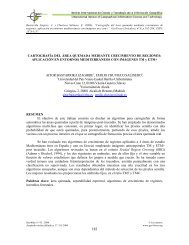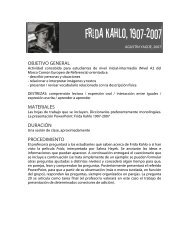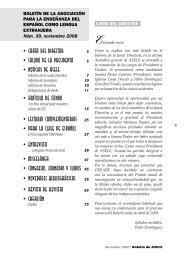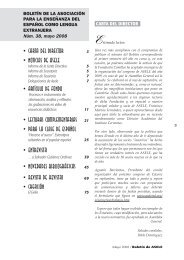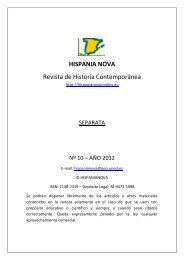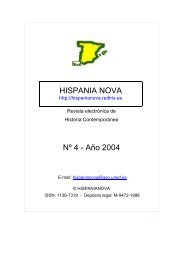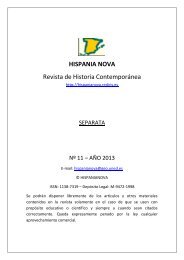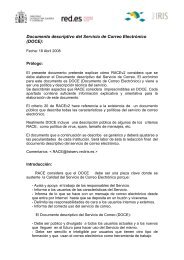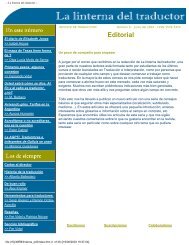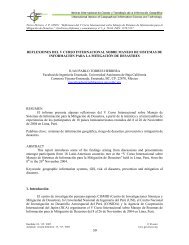Preparing an IPv6 Addressing Plan Manual - RedIRIS
Preparing an IPv6 Addressing Plan Manual - RedIRIS
Preparing an IPv6 Addressing Plan Manual - RedIRIS
- No tags were found...
You also want an ePaper? Increase the reach of your titles
YUMPU automatically turns print PDFs into web optimized ePapers that Google loves.
Media RelationsTamburi Investment Partners S.p.A.Contatto: Cristina CalderoniTel. +39 028858801 Cell. +39 3358221685ccalderoni@tamburi.comTel: +39 02 45473884/3E-mail: ir@damicointernationalshipping.com
Each digit in the hexadecimal system is equivalent to 4 bits; <strong>an</strong> <strong>IPv6</strong> address of 128bits therefore consists of 128/4 = 32 hexadecimal digits. The notation is as follows:2001:0db8:0000:0000:0000:0000:0000:0000Since it is impractical to record all these zeroes, they may be skipped in accord<strong>an</strong>cewith certain conventions; leading zeroes c<strong>an</strong> be dropped for <strong>an</strong>y group of digitsbetween two colons. The result would then be:2001:db8:0:0:0:0:0:0A series of zeroes <strong>an</strong>d colons may also be abbreviated as two colons. The result isnow:2001:db8::The precise rules for writing <strong>IPv6</strong> addresses are recorded in RFC 5952.¹2.2Grouping Addresses (prefixes)<strong>IPv6</strong> addresses are grouped using the binary value of the address. This grouping iscarried out using a “prefix”. Prefixes are all addresses that start with the same seriesof bits. The length of the identical series is noted after the address, separated by aforward slash. The prefix2001:db8::/32thus contains all the addresses from2001:0db8:0000:0000:0000:0000:0000:0000through2001:0db8:ffff:ffff:ffff:ffff:ffff:ffff1http://tools.ietf.org/html/rfc5952#page-104<strong>Preparing</strong> <strong>an</strong> <strong>IPv6</strong> <strong>Addressing</strong> Pl<strong>an</strong>
As c<strong>an</strong> be seen above, the first 32 bits, i.e. the first eight hexadecimal digits, areidentical. The prefix2001:db8:1234::/64contains all the addresses from2001:0db8:1234:0000:0000:0000:0000:0000through2001:0db8:1234:0000:ffff:ffff:ffff:ffffIt is common practice to separate the different groups in multiples of four bits. Thismakes it much easier to decipher the addresses. This is why the prefixes /48, /52,/56, /60 <strong>an</strong>d /64 are commonly used. If a group is not separated at a multiple offour, the addresses become much more difficult to decipher (see box).Prefix not a multiple of fourIf the prefix length is not a round multiple of four, the binary separation will takeplace in the middle of a hexadecimal number. This me<strong>an</strong>s that all hexadecimalnumbers that start with the same series of bits will belong to this prefix. The prefix2001:db8::/61thus contains all the addresses from2001:0db8:0000:0000:0000:0000:0000:0000through2001:0db8:0000:0007:ffff:ffff:ffff:ffffbecause the hexadecimal numbers 0 through 7 all start with the binary value 0.For example, the prefix2001:db8:0:8::/615<strong>Preparing</strong> <strong>an</strong> <strong>IPv6</strong> <strong>Addressing</strong> Pl<strong>an</strong>
contains all the addresses from2001:0db8:0000:0008:0000:0000:0000:0000through2001:0db8:0000:000f:ffff:ffff:ffff:ffffbecause the hexadecimal numbers 8 to f all start with the binary value 1.2.3Assigning Address Blocks<strong>IPv6</strong> address r<strong>an</strong>ges are assigned as follows:Prefix Assigned to Number of addresses/32 LIR (Local Internet Registry,usually <strong>an</strong> InternetService Provider)2 96/48 Org<strong>an</strong>isation 2 80/64 Org<strong>an</strong>isation network(subnet)/128 Host (PC, server, printer,router)2 641In this m<strong>an</strong>ual, it is assumed that all networks use a /64 address block. Other addressblocks may be used, but we do not recommend this because some equipment maywork differently with other formats.Also, it is assumed that your org<strong>an</strong>isation has been allocated a /48 address block,<strong>an</strong>d that 16 bits (64-48) are therefore available for assigning the addresses tonetworks. If your situation is different, you will need to adapt the calculations in thism<strong>an</strong>ual accordingly.Based on the above information, the first 48 bits of your <strong>IPv6</strong> pl<strong>an</strong> are fixed. In thisdocument, we use 2001:db8:1234::/48 as <strong>an</strong> example. This me<strong>an</strong>s you c<strong>an</strong> use the/64 prefixes2001:db8:1234:0000::/646<strong>Preparing</strong> <strong>an</strong> <strong>IPv6</strong> <strong>Addressing</strong> Pl<strong>an</strong>
through2001:db8:1234:ffff::/64for your network – 16 bits in total.For your own addressing pl<strong>an</strong>, you will need to replace the numbers in the exampleswith the prefix allocated to you.2.4Notation of the Assigned AddressesIn this m<strong>an</strong>ual, we will subdivide the 16 available bits into groups. We distinguishthe following types of groups:B: bit is assignableL: bit is assigned to a locationG: bit is assigned to a use typeThe following notation is used for the assigned bits. The order of the letters here arer<strong>an</strong>dom <strong>an</strong>d are only used as <strong>an</strong> example:2001:db8:1234: L L L L G G G G B B B B B B B B ::/64Each box represents 1 bit. Four boxes together therefore represent one hexadecimaldigit in the <strong>IPv6</strong> address. For the above example, this produces the following addressstructure:2001:db8:1234:LGBB::/64Bits 1-4 are in this example assigned to a location, bits 5-8 are assigned to a usetype <strong>an</strong>d bits 9-16 remain available to be assigned to <strong>an</strong>other purpose.33.1OPTIONS FOR WORKING WITHOUT AN ADDRESSING PLANNo <strong>Addressing</strong> Pl<strong>an</strong>Small, flat org<strong>an</strong>isations that do not have <strong>an</strong> internal org<strong>an</strong>isational structure (withseveral departments within the org<strong>an</strong>isation being authorised to assign IP addresses)or technical structure (distinguishing between various categories of use types <strong>an</strong>dnetworks) c<strong>an</strong> work without <strong>an</strong> addressing pl<strong>an</strong>, instead assigning a r<strong>an</strong>dom free<strong>IPv6</strong> address as network host.A disadv<strong>an</strong>tage is that it c<strong>an</strong> be difficult to recognise networks based on theiraddress because this method lacks structure. For this reason, we recommendpreparing <strong>an</strong> addressing pl<strong>an</strong>.7<strong>Preparing</strong> <strong>an</strong> <strong>IPv6</strong> <strong>Addressing</strong> Pl<strong>an</strong>
Should you opt to work without <strong>an</strong> addressing pl<strong>an</strong>, we recommend keeping a list ofthe assigned networks in a central location, such as <strong>an</strong> Excel spreadsheet, <strong>an</strong> internalWiki page or in the reverse DNS configuration.3.2Direct Link Between IPv4 <strong>an</strong>d <strong>IPv6</strong> AddressesIf the existing IPv4 networks use only /24 subnets (for example, from 203.0.113.0 to203.0.113.255), a direct link c<strong>an</strong> be established between IPv4 addresses <strong>an</strong>d the new<strong>IPv6</strong> addresses. In this case, you c<strong>an</strong> include the penultimate number of the IPv4address (113 in 203.0.113.0/24, for example) in the <strong>IPv6</strong> subnet. The <strong>IPv6</strong> addresswill then be 2001:db8:1234:113::/64.Such <strong>an</strong> IPv4-to-<strong>IPv6</strong> tr<strong>an</strong>sition could appear as follows:In this addressing pl<strong>an</strong>, the link between the existing IPv4 networks <strong>an</strong>d the <strong>IPv6</strong>networks is immediately visible.For vital equipment, such as servers <strong>an</strong>d routers, it may be practical to use the lastnumber of the IPv4 address in the <strong>IPv6</strong> Address too. The IPv4 address 192.0.2.123,for example, would become the <strong>IPv6</strong> address 2001:db8:1234:2::123. It is alsopossible to incorporate the entire IPv4 address into the <strong>IPv6</strong> address. In this case,the <strong>IPv6</strong> address would be 2001:db8:1234:2:192:0:2:123.Should you choose this option, we recommend keeping a list of the assignednetworks in a central location, such as <strong>an</strong> Excel spreadsheet, <strong>an</strong> internal Wiki page orin the reverse DNS configuration.44.1PREPARING AN ADDRESSING PLAN FOR A NETWORKIntroductionWhen preparing your addressing pl<strong>an</strong> you have to decide which system to use toassign the available addresses to the networks in the org<strong>an</strong>isation. There are <strong>an</strong>umber of convenient methods for assigning addresses.8<strong>Preparing</strong> <strong>an</strong> <strong>IPv6</strong> <strong>Addressing</strong> Pl<strong>an</strong>
The present chapter will describe the possible addressing pl<strong>an</strong>s, using the followingexample network:4.2Basic Structure of the <strong>Addressing</strong> Pl<strong>an</strong>With the <strong>IPv6</strong> protocol, there are so m<strong>an</strong>y available addresses that we c<strong>an</strong> createone or more primary subnets. We c<strong>an</strong>, for example, assign the addresses per usetype or per location, or use combinations. For example, we may assign the addressesfirst by use type <strong>an</strong>d then by location. Once these subnets have been defined, therewill still be bits remaining that c<strong>an</strong> be assigned to <strong>an</strong>other purpose.Take the example in section 2.4:2001:db8:1234: L L L L G G G G B B B B B B B B ::/64In this example, 4 bits are assigned to a location (L) <strong>an</strong>d 4 bits are assigned to a usetype (G). As a result, there are 8 bits remaining (B). Following this addressing pl<strong>an</strong>,16 1 locations c<strong>an</strong> be addressed, with each location having 16 2 allocatable use types.Each of these locations c<strong>an</strong> create 256 3 networks per use type.4.3Defining a Primary SubnetWe first need to decide on the addressing of the primary subnets. We recommendchoosing the location or the use type (such as students, staff, servers, switches,routers, public, etc.) as the primary subnet. These options are discussed below.4.3.1LocationWhen the location is the primary subnet, each building, department etc. is assigned <strong>an</strong>umber of dedicated addresses. The emphasis in this case lies on optimisation of therouting tables. All the networks within a single location will be aggregated to a singleroute in the routing table, so that the routing table will remain compact.1Number of possible combinations of the 4 location bits2Number of possible combinations of the 4 use type bits3Number of possible combinations of the 8 assignable bits9<strong>Preparing</strong> <strong>an</strong> <strong>IPv6</strong> <strong>Addressing</strong> Pl<strong>an</strong>
4.3.2Use typeWhen the use type is the primary subnet, the routing optimisation described aboveis not feasible, because the use types are divided across a number of locations.However, in practice this will not be a problem with most routers.This option does make it much easier to implement a security policy. Most firewallpolicies are based on the type of use <strong>an</strong>d not on the location of the network. This iswhy the firewalls often require only one policy per use type.4.3.3RecommendationBased on the above information, we recommend use type-based primary subnets,because this is the easiest way to integrate with existing policies <strong>an</strong>d procedures.Possible reasons for location-based primary subnets are:• Some locations will prepare their own addressing pl<strong>an</strong>• The routers c<strong>an</strong>not process such a large number of routes without aggregation4.4Determining the Address Space Required for the <strong>Addressing</strong> Pl<strong>an</strong> of ChoiceNow we need to determine which portion of the 16 bits of available address space(see section 2.3) is required for the addressing pl<strong>an</strong> selected. The number of groupsin the primary subnet determines the number of bits required. One bit c<strong>an</strong> containtwo groups (2 1 ), 2 bits c<strong>an</strong> contain 4 groups (2 2 ), etc. (see also the appendix).We c<strong>an</strong> determine the number of groups as follows:1. First determine the number of locations or use types within your org<strong>an</strong>isation.Count each location or use type as one group.2. Increase this number by one group (required for the backbone <strong>an</strong>d otherinfrastructure).3. If you chose to work with location-based primary subnets, add one extra groupfor all networks that do not have a fixed location. These are networks for VPNs<strong>an</strong>d tunnels, for example.4. Add one or two groups to allow for future exp<strong>an</strong>sion.5. To create a practical addressing pl<strong>an</strong>, the number of blocks into which we dividethe address space should be to a power of 2. So we’ll round up the number ofbits counted in steps 1 to 4 to the nearest power of 2.The result is the number of groups in the primary subnet, either by location or byuse type.This method is explained using a number of examples. More detailed examples c<strong>an</strong>be found in chapter 5.10<strong>Preparing</strong> <strong>an</strong> <strong>IPv6</strong> <strong>Addressing</strong> Pl<strong>an</strong>
Example 1: Location-based subnetIn this example, we define the locations as the primary subnets. The number ofgroups required is then as follows:Number of locations:Backbone <strong>an</strong>d other infrastructure:Non-location-based networks:Future locations:Total:Three groupsOne groupOne groupTwo groupsSeven groupsThis example network would then appear as follows: If we round this up to the first power of 2, this results in eight subnets. Incorporatingthese primary subnets into the <strong>IPv6</strong> address requires 3 bits (L) (2 3 = 8; see also theappendix) This results in the following bit distribution:2001:db8:1234: L L L B B B B B B B B B B B B B ::/64This leaves 13 available bits (B).11<strong>Preparing</strong> <strong>an</strong> <strong>IPv6</strong> <strong>Addressing</strong> Pl<strong>an</strong>
Example 2: Use type-based subnetIn this example we define the use types as the primary subnets. The number ofgroups required is then as follows:Number of use types (staff,students, guests, servers <strong>an</strong>d VPNs):Backbone <strong>an</strong>d other infrastructure:Future use types:Total:Five groupsOne groupFour groupsTen groupsThis example network would then appear as follows:If we round this up to the first power of 2, this results in 16 subnets. Incorporatingthese subnets into the <strong>IPv6</strong> address requires 4 bits (G) (2 4 = 16). This leaves 12available bits (B).2001:db8:1234: G G G G B B B B B B B B B B B B ::/6412<strong>Preparing</strong> <strong>an</strong> <strong>IPv6</strong> <strong>Addressing</strong> Pl<strong>an</strong>
4.5Optional Secondary SubnetsThe remaining bits c<strong>an</strong> be used for numbering secondary subnetworks withinthe selected addressing pl<strong>an</strong>. If the primary subnets are location-based, multiplenetworks c<strong>an</strong> be addressed by location, whereas if the primary subnets are use typebased,multiple student networks or server networks c<strong>an</strong> be addressed, for example.The remaining bits c<strong>an</strong> also be used to combine subnets by location <strong>an</strong>d use type.If the subnet is location-based, as in example 1, <strong>an</strong>d we create a use type-basedsecondary subnet, as in example 2, the result is as follows:2001:db8:1234: L L L G G G G B B B B B B B B B ::/64In this addressing pl<strong>an</strong>, there is space for eight locations, each with 16 use types.Within each use type, there are yet <strong>an</strong>other 512 (2 9 due to 9 available bits)secondary subnetworks available.This combination of primary <strong>an</strong>d secondary subnets uses location-based primarysubnets. This will make it easier to optimise routing tables, but it will complicate thedesign of the security policy. This is because firewall policies c<strong>an</strong> only be applied onthe basis of the first numbers of <strong>an</strong> address, while in this example the location is atthe start of the address, not the use type.To facilitate the design process for the security policy, the combination c<strong>an</strong> bereversed by making the primary subnet use type-based, as in example 2, <strong>an</strong>d thesecondary subnets location-based, as in example 1. The result is then as follows:2001:db8:1234: G G G G L L L B B B B B B B B B ::/64In this example, the use type is at the start of the address, making it easier to applyfirewall policies per use type. Since the use type is typically more relev<strong>an</strong>t forsecurity policies th<strong>an</strong> the location, we recommend using this system.4.6ControlWe c<strong>an</strong> check whether the addressing pl<strong>an</strong> we have created meets our requirementsby counting the number of bits remaining after creation of the primary <strong>an</strong>dsecondary subnets. If, for example, after the creation of use type-based primarysubnets containing location-based secondary subnets we also require multiplestudent networks at each location, there will have to be enough bits left to createthese.In the example in section 4.5 there are 9 bits remaining, which results in 512 (2 9 )possible values per use type per location. This will usually be more th<strong>an</strong> enough.4.7LeewayIf the number of remaining bits is not quite sufficient, this c<strong>an</strong> be compensated for inthe assignment of the primary <strong>an</strong>d secondary subnets.13<strong>Preparing</strong> <strong>an</strong> <strong>IPv6</strong> <strong>Addressing</strong> Pl<strong>an</strong>
In the above example we used 4 bits for the use types <strong>an</strong>d 3 bits for the locations.That leaves 9 bits, so we c<strong>an</strong> create 512 (2 9 ) networks per use type per location.2001:db8:1234: G G G G L L L B B B B B B B B B ::/64This will be sufficient in most cases. However, it may be that we require 2,048 VPNnetworks per location. This c<strong>an</strong> be done by ch<strong>an</strong>ging the assignment of primary <strong>an</strong>dsecondary subnets. However, the <strong>IPv6</strong> address will become more difficult to decipherin hexadecimal format. Another option is to reserve four groups within the use typesubnets for VPN networks. If we sort the numbers of this group of four in binarynumber groupings (decimal: 0-3, 4-7, 8-11 of 12-15; hexadecimal: 0-3, 4-7, 8-B, C-F)then these c<strong>an</strong> still be covered by a single firewall policy.The following groups might result:0 Backbone <strong>an</strong>d other infrastructure1 Servers2 Future exp<strong>an</strong>sion3 Future exp<strong>an</strong>sion4 Staff5 Students6 Guests7 Future exp<strong>an</strong>sion8 VPNs9 VPNsA VPNsB VPNsC Future exp<strong>an</strong>sionD Future exp<strong>an</strong>sionE Future exp<strong>an</strong>sionF Future exp<strong>an</strong>sion4.8LegibilityIf there are enough bits remaining, we c<strong>an</strong> use them to make <strong>IPv6</strong> addresses morelegible. Each hexadecimal digit in a <strong>IPv6</strong> address is equivalent to 4 bits. By choosing<strong>an</strong> assignment system based on multiples of 4 bits, each group will correspond witha digit in the <strong>IPv6</strong> address.In the example in this section, we used 3 bits per location <strong>an</strong>d 4 bits per use type.By using 4 bits for the location, we increase the legibility, because then both thelocation <strong>an</strong>d the use type are conveniently arr<strong>an</strong>ged into a 4-bit group:14<strong>Preparing</strong> <strong>an</strong> <strong>IPv6</strong> <strong>Addressing</strong> Pl<strong>an</strong>
2001:db8:1234:L L L G G G G B B B B B B B B B ::/64Becomes:2001:db8:1234:G GG GL LL BB BB BB BB B::/642001:db8:1234: L L L L G G G G B B B B B B B B ::/64The 4 L bits are displayed as one hexadecimal digit in the <strong>IPv6</strong> address. The four Gbits are also displayed as one hexadecimal digit. This results in the following <strong>IPv6</strong>address structure:2001:db8:1234:LGBB::/64Using this system, the location <strong>an</strong>d use type c<strong>an</strong> easily be identified in the <strong>IPv6</strong>address. The first symbol indicates the location (L) <strong>an</strong>d the second indicates the usetype (G).4.9Using VLAN NumbersSome org<strong>an</strong>isations have already included a location <strong>an</strong>d/or use type descriptionin their VLAN numbering pl<strong>an</strong>. If this is the case, you might consider tr<strong>an</strong>sferringthese numbers directly to the <strong>IPv6</strong> addressing system rather th<strong>an</strong> using the methoddescribed above.If the VLAN number system is not location-based or use type-based, it is alsopossible to tr<strong>an</strong>sfer the VLAN numbers directly to the <strong>IPv6</strong> address. This makes iteasy for system m<strong>an</strong>agers to identify the relationship between the VLAN <strong>an</strong>d the<strong>IPv6</strong> address. However, as the use type <strong>an</strong>d location do not appear in the <strong>IPv6</strong>address, it will not be possible to optimise the security policies <strong>an</strong>d routing tables.For this reason, we do not recommend this method of addressing.A VLAN number is 12 bits long, while we have 16 bits available with <strong>an</strong> <strong>IPv6</strong>address. If we only use the VLAN number in our addressing pl<strong>an</strong>, this will lead to awaste of 15/16ths of the <strong>IPv6</strong> addresses. This will probably not be a problem forsmaller org<strong>an</strong>isations, <strong>an</strong>d it might even be practical.There are two methods of dealing with this:1. We might incorporate the VLAN number decimally into the <strong>IPv6</strong> address. Thehexadecimal digits A to F will remain unused. This format is easily legible, but it15<strong>Preparing</strong> <strong>an</strong> <strong>IPv6</strong> <strong>Addressing</strong> Pl<strong>an</strong>
is less suited to implementing firewall policies, which are based on the bits in theaddress <strong>an</strong>d are thus compatible with the hexadecimal format.2. The VLAN number c<strong>an</strong> be incorporated into the <strong>IPv6</strong> address hexadecimally,so that one hexadecimal digit in the <strong>IPv6</strong> address will remain unused. If, forexample, we choose to leave the left digit as 0, we c<strong>an</strong> still use the digits 1through F for the hexadecimal notation.For inst<strong>an</strong>ce:VLAN number <strong>IPv6</strong> decimal <strong>IPv6</strong> hexadecimal1 2001:db8:1234:0001::/64 2001:db8:1234:0001::/6412 2001:db8:1234:0012::/64 2001:db8:1234:000c::/644094 2001:db8:1234:4094::/64 2001:db8:1234:0ffe::/644.9.1Reversing VLAN notations in <strong>an</strong> <strong>IPv6</strong> structureThere are also options for reversing previously defined VLAN notations. If, forexample, the VLAN numbers are assigned first by location <strong>an</strong>d then by use type, it isstill possible to assign the <strong>IPv6</strong> addresses in the reverse order: first by use type <strong>an</strong>dthen by location.In the following example of a VLAN structure, the hexadecimal notation of the VLANnumber, location <strong>an</strong>d use type is placed between brackets:VLAN number Location Use type0001 (001) 0 (0) 1 (01)0529 (211) 2 (2) 17 (11)4094 (FFE) 15 (F) 254 (FE)In this example, the first 4 bits of the VLAN number identify the location. Theremaining 8 bits describe the use type. By copying this directly to the <strong>IPv6</strong> address,we are able to optimise the routing table, but not the security policy. The reason forthis is that the location is at the start of the address while the use type follows it.However, if we wish to use the <strong>IPv6</strong> addresses to optimise the security policies, theuse type has to be at the start of the address.To arr<strong>an</strong>ge this, we c<strong>an</strong> move the first 4 bits of the VLAN number (which describethe location) to the back to become the last 4 bits of the <strong>IPv6</strong> subnet. The last 8 bitsof the VLAN number (which describe the use type) c<strong>an</strong> be placed in front of these.4.9.2Hexadecimal notationHexadecimal notation is further explained using the example below. Thehexadecimal notation of the VLAN number, location <strong>an</strong>d use type is placed betweenbrackets.16<strong>Preparing</strong> <strong>an</strong> <strong>IPv6</strong> <strong>Addressing</strong> Pl<strong>an</strong>
VLAN number Location Use type <strong>IPv6</strong> hexadecimal0001 (001) 0 (0) 1 (01) 2001:db8:1234:0010::/640529 (211) 2 (2) 17 (11) 2001:db8:1234:0112::/644094 (FFE) 15 (F) 254 (FE) 2001:db8:1234:0fef::/644.9.3Decimal notationA similar notation system c<strong>an</strong> be used if the VLAN number is divided decimally. If,for example, the first two digits indicate the location <strong>an</strong>d the last two digits the usetype, this c<strong>an</strong> be reversed in the <strong>IPv6</strong> address. For example:VLAN number Location Use type <strong>IPv6</strong> decimal0001 00 01 2001:db8:1234:0100::/640529 05 29 2001:db8:1234:2905::/644094 40 94 2001:db8:1234:9440::/644.10<strong>Addressing</strong> Point-to-point LinksIf you use point-to-point links, using a /64 address may present problems incombination with certain router configurations. Unused addresses in the /64 systemare bounced back by the routers on either side of the link. Data packages sent to thisaddress will thus be sent back <strong>an</strong>d forth between the routers like ping pong balls.This places <strong>an</strong> unw<strong>an</strong>ted burden on the network. It might therefore, be practical insome cases to configure a /127 prefix instead of a /64 for these links.Please note: this configuration often works, but it is not in accord<strong>an</strong>ce with <strong>IPv6</strong>st<strong>an</strong>dards.We therefore recommend reserving a /64 prefix for such links in the addressingpl<strong>an</strong>, even if you use only a /127. As soon as the router configuration has beencorrected by the supplier, you may proceed to configure a /64 prefix without havingto modify the addressing pl<strong>an</strong>.17<strong>Preparing</strong> <strong>an</strong> <strong>IPv6</strong> <strong>Addressing</strong> Pl<strong>an</strong>
55.1DETAILED EXAMPLESAssigning by Use Type OnlyA use type-based subnet has been adopted in which the following groups aredistinguished:Number of use types (students,staff, guests, servers):Backbone <strong>an</strong>d other infrastructure:Total:Four groupsOne groupFive groupsIf we round this up to the first power of 2, this results in eight primary subnets.Incorporating these groups into the <strong>IPv6</strong> address requires 3 bits (2 3 = 8). With threeunused groups, there is enough space for future exp<strong>an</strong>sion.We have used 3 of the available 16 bits; as a result, 13 still remain. We decide notto divide these into secondary subnets. To increase legibility, we use 4 bits peruse type so that 12 bits remain. This leaves address space for 4,096 (2 12 ) possiblenetworks per use type. Now there are 12 bits still available:2001:db8:1234: G G G G B B B B B B B B B B B B ::/64This results in the following address structure:2001:db8:1234:GBBB::/64The table below illustrates this:Use type (G) Assignable (B) NetworkInfrastructure (0) 0 2001:db8:1234:0000::/64Infrastructure (0) 1 2001:db8:1234:0001::/64Infrastructure (0) 12 2001:db8:1234:000c::/64Infrastructure (0) 100 2001:db8:1234:0064::/64Students (1) 0 2001:db8:1234:1000::/64Students (1) 12 2001:db8:1234:100c::/64Students (1) 321 2001:db8:1234:1141::/64Etc.18<strong>Preparing</strong> <strong>an</strong> <strong>IPv6</strong> <strong>Addressing</strong> Pl<strong>an</strong>
5.2Assigning by Use Types <strong>an</strong>d LocationsWe w<strong>an</strong>t to set up a use type-based primary subnet <strong>an</strong>d a location-based secondarysubnet.The following use types are distinguished:Number of use types (students,staff, guests, servers):Backbone <strong>an</strong>d other infrastructure:Total:Four groupsOne groupFive groupsIf we round this up to the first power of 2, this results in eight groups. Incorporatingthese groups into the <strong>IPv6</strong> address requires 3 bits (2 3 = 8). With three unusedgroups, there is enough space for future exp<strong>an</strong>sion.This example is based on 35 locations. If we use 6 bits, we will have address spacefor 64 (26) locations, which is more th<strong>an</strong> enough.We have now assigned 9 bits to the primary <strong>an</strong>d secondary subnets, <strong>an</strong>d so 7remain. We c<strong>an</strong> use these 7 bits to create 128 (2 7 ) networks per use type perlocation.In this example, we decide not to make <strong>an</strong>y modifications to improve legibility. Werecommend that you do make such modifications in practice, but in this example wewish to demonstrate the impact of a sub-optimum addressing pl<strong>an</strong> on legibility.We now have the following <strong>IPv6</strong> address structure:2001:db8:1234: G G G L L L L L L B B B B B B B ::/64This results in the following example addresses. It is obvious that the groups c<strong>an</strong>notbe traced in the address:Use type Location Assignable NetworkInfrastructure(0)Infrastructure(0)Infrastructure(0)Non-locationbased(0)Non-locationbased(0)Non-locationbased(0)0 2001:db8:1234:0000::/641 2001:db8:1234:0001::/642 2001:db8:1234:0002::/64Infrastructure(0)Infrastructure(0)Location 1 0 2001:db8:1234:0080::/64Location 35 0 2001:db8:1234:1180::/64Students (1)Non-locationbased(0)0 2001:db8:1234:2000::/6419<strong>Preparing</strong> <strong>an</strong> <strong>IPv6</strong> <strong>Addressing</strong> Pl<strong>an</strong>
Etc.Students (1) Location 1 12 2001:db8:1234:208c::/64Students (1) Location 35 9 2001:db8:1234:3189::/645.3Improving LegibilityAlthough the assignment method used in the previous example may well functionperfectly, it makes it very difficult to decipher addresses. To improve legibility, wewill divide the addresses into groups of 4 bits.We will use 4 bits for the use type <strong>an</strong>d 8 bits for the locations. This leaves us 4 bitsto create networks per use type per location. It is import<strong>an</strong>t to check whether these4 bits are sufficient. An example of a situation where 4 bits would be insufficientis if there are to be more th<strong>an</strong> 16 (24) student networks per location. We c<strong>an</strong> thenuse the extra leeway created by using <strong>an</strong> extra bit for the use type as described insection 2.4.This results in the following situation:2001:db8:1234: G G G G L L L L L L L L B B B B ::/64The following address structure is created:2001:db8:1234:GLLB::/64The table below illustrates this:Use type Location Assignable NetworkInfrastructure(0)Infrastructure(0)Infrastructure(0)Non-locationbased(0)0 2001:db8:1234:0000::/641 2001:db8:1234:0001::/642 2001:db8:1234:0002::/64Infrastructure(0)Infrastructure(0)Location 1 0 2001:db8:1234:0010::/64Location 35 0 2001:db8:1234:0230::/64Students (1)Non-locationbased(0)0 2001:db8:1234:1000::/64Students (1) Location 1 12 2001:db8:1234:101c::/6420<strong>Preparing</strong> <strong>an</strong> <strong>IPv6</strong> <strong>Addressing</strong> Pl<strong>an</strong>
Students (1) Location 35 9 2001:db8:1234:1239::/64Etc.66.16.1.1MANAGING HOSTS<strong>Addressing</strong> HostsIntroductionOnce we have <strong>an</strong> addressing pl<strong>an</strong> for the <strong>IPv6</strong> networks, we c<strong>an</strong> proceed to addressthe hosts in the network. There are three common methods for doing this:• StateLess Address Auto Configuration (SLAAC)• Dynamic Host Configuration Protocol for <strong>IPv6</strong> (DHCPv6)• Static <strong>IPv6</strong> addressesWe recommend automatic configuration via SLAAC or DHCPv6 for most clientsbecause this makes m<strong>an</strong>agement considerably easier. If properly implemented, italso increases the privacy of the users. A static configuration is recommended onlyfor equipment such as routers, switches, firewalls <strong>an</strong>d servers.6.1.2StateLess Address Auto Configuration (SLAAC)SLAAC is the simplest way to link hosts to <strong>an</strong> <strong>IPv6</strong> network. The router sends “RouterAdvertisements” (RAs) <strong>an</strong>d the hosts use the information in the RA in combinationwith their MAC address to assign <strong>an</strong> <strong>IPv6</strong> address.If multiple routers in a single network send RAs, the hosts will listen to both RAs<strong>an</strong>d configure addresses on both networks. This feature c<strong>an</strong> be used to incorporate adegree of redund<strong>an</strong>cy.6.1.3Privacy extensionsSome operating systems have privacy extensions in addition to SLAAC. Dependingon the operating system, these will be either active or inactive by default. Privacyextensions ensure that third parties c<strong>an</strong>not see what kind of network card a hosthas. In st<strong>an</strong>dard SLAAC this is visible because the MAC address is used for loggingon to a network. Because the same MAC address is used for logging on to variousnetworks (for example, with a smartphone), third parties c<strong>an</strong> see that one <strong>an</strong>d thesame host is being used. Privacy extensions use multiple r<strong>an</strong>dom addresses per hostto prevent the host from being traced.However, the use of privacy extensions in combination with SLAAC is problematicif network m<strong>an</strong>agers wish to trace who is using which <strong>IPv6</strong> address <strong>an</strong>d when. Onesolution is to use centrally coordinated address assignment via DHCPv6 (see section6.1.4). However, this is not supported by all operating systems at present. Onecommon operating system that does not support DHCPv6 is Mac OS X. Also, DHCPv6software is not installed as st<strong>an</strong>dard by all Linux <strong>an</strong>d BSD distributors.21<strong>Preparing</strong> <strong>an</strong> <strong>IPv6</strong> <strong>Addressing</strong> Pl<strong>an</strong>
6.1.4Dynamic Host Configuration Protocol for <strong>IPv6</strong> (DHCPv6)DHCPv6 c<strong>an</strong> be implemented in two ways:• DHCPv6 c<strong>an</strong> collaborate with SLAAC to provide hosts with all the informationthat SLAAC does not provide, such as DNS domains <strong>an</strong>d servers <strong>an</strong>d NTP servers.• DHCPv6 c<strong>an</strong> be used as a substitute for SLAAC. In this case the <strong>IPv6</strong> addressesare explicitly distributed by the DHCPv6 server.DHCPv6 c<strong>an</strong> provide more control, but it is not supported by all hosts. If addressesare assigned with DHCPv6, it is recommended to program the switches so that hostsc<strong>an</strong> only use the addresses assigned to them via DHCPv6.Please note: this is not st<strong>an</strong>dard for either IPv4 or <strong>IPv6</strong>. M<strong>an</strong>y suppliers haveimplemented their own security policies for IPv4. There are only a few switchesavailable that offer this security with <strong>IPv6</strong>.Therefore, traceability based on the MACaddress would still be the best option in this situation.6.1.5Static AddressesWe recommend assigning static <strong>IPv6</strong> addresses only for equipment such as routers,switches, firewalls <strong>an</strong>d servers. Automatic configuration of such equipment willlead to problems in the long run. For example, if the network adaptor on a server isreplaced, the SLAAC address of that server will also ch<strong>an</strong>ge, <strong>an</strong>d there is a major riskthat the person replacing the network adaptor will forget to modify the DNS entriesfor the server.To increase the traceability of vital equipment, we recommend incorporating all orpart of the IPv4 address into the <strong>IPv6</strong> address. This is explained in more detail insection 3.2.APPENDIX: RATIO BETWEEN GROUPS AND BITSNumber of groupsNumber of bits2 14 28 316 432 564 6128 7256 8512 91024 1022<strong>Preparing</strong> <strong>an</strong> <strong>IPv6</strong> <strong>Addressing</strong> Pl<strong>an</strong>
2048 114096 128192 1316384 1432768 1565536 16AcknowledgementsThis m<strong>an</strong>ual was produced with the assist<strong>an</strong>ce of the following people, whom wewould like to th<strong>an</strong>k:S<strong>an</strong>der Steff<strong>an</strong>n, authorRoel Hoek (University of Twente)Jeroen v<strong>an</strong> Ingen Schenau (University of Twente)Magda Pattiapon (RUG)Mente Heemstra (RUG)Rogier Spoor (SURFnet)Wim Biemolt (SURFnet)Niels den Otter (SURFnet)Maurice v<strong>an</strong> den Akker (SURFnet)J<strong>an</strong> Michielsen (SURFnet)Tr<strong>an</strong>slation provided by RIPE NCC23<strong>Preparing</strong> <strong>an</strong> <strong>IPv6</strong> <strong>Addressing</strong> Pl<strong>an</strong>




